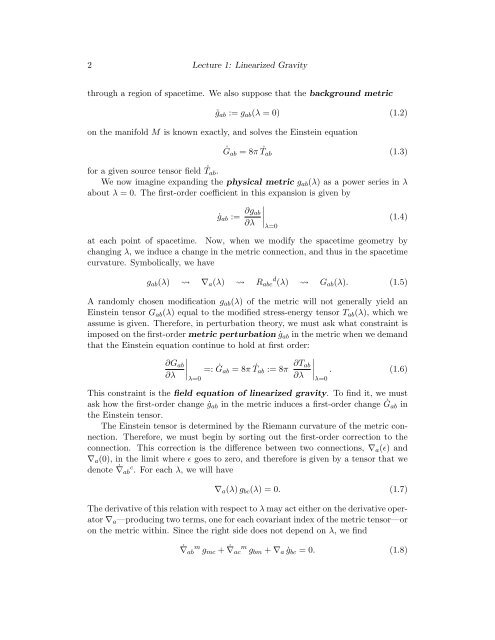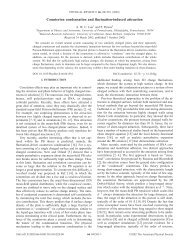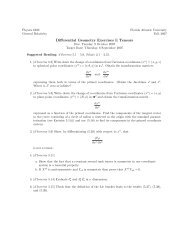Linearized Gravity
Linearized Gravity
Linearized Gravity
Create successful ePaper yourself
Turn your PDF publications into a flip-book with our unique Google optimized e-Paper software.
2 Lecture 1: <strong>Linearized</strong> <strong>Gravity</strong>through a region of spacetime. We also suppose that the background metric˚g ab := g ab (λ = 0) (1.2)on the manifold M is known exactly, and solves the Einstein equation˚G ab = 8π ˚T ab (1.3)for a given source tensor field ˚T ab .We now imagine expanding the physical metric g ab (λ) as a power series in λabout λ = 0. The first-order coefficient in this expansion is given byġ ab := ∂g ab∂λ∣ (1.4)λ=0at each point of spacetime. Now, when we modify the spacetime geometry bychanging λ, we induce a change in the metric connection, and thus in the spacetimecurvature. Symbolically, we haveg ab (λ) ∇ a (λ) R abc d (λ) G ab (λ). (1.5)A randomly chosen modification g ab (λ) of the metric will not generally yield anEinstein tensor G ab (λ) equal to the modified stress-energy tensor T ab (λ), which weassume is given. Therefore, in perturbation theory, we must ask what constraint isimposed on the first-order metric perturbation ġ ab in the metric when we demandthat the Einstein equation continue to hold at first order:∂G ab∂λ∣ =: Ġ ab = 8π T ˙ ab := 8π ∂T abλ=0∂λ ∣ . (1.6)λ=0This constraint is the field equation of linearized gravity. To find it, we mustask how the first-order change ġ ab in the metric induces a first-order change Ġab inthe Einstein tensor.The Einstein tensor is determined by the Riemann curvature of the metric connection.Therefore, we must begin by sorting out the first-order correction to theconnection. This correction is the difference between two connections, ∇ a (ɛ) and∇ a (0), in the limit where ɛ goes to zero, and therefore is given by a tensor that wedenote ˙∇ ab c . For each λ, we will have∇ a (λ) g bc (λ) = 0. (1.7)The derivative of this relation with respect to λ may act either on the derivative operator∇ a —producing two terms, one for each covariant index of the metric tensor—oron the metric within. Since the right side does not depend on λ, we find˙∇ ab m g mc + ˙∇ ac m g bm + ∇ a ġ bc = 0. (1.8)






